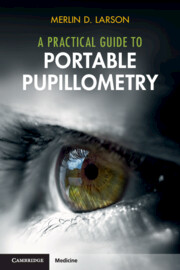Book contents
- A Practical Guide to Portable Pupillometry
- Reviews
- A Practical Guide to Portable Pupillometry
- Copyright page
- About the Author
- Contents
- Preface
- Acknowledgements
- Glossary
- Introduction
- Chapter 1 Early History of the Pupil
- Chapter 2 Anatomy of the Pupil
- Chapter 3 Physiology of the Pupil
- Chapter 4 Pharmacology of the Pupil
- Chapter 5 Unusual Pupillary Syndromes
- Chapter 6 Measurement of the Pupil
- Chapter 7 Pupil Size
- Chapter 8 Pupillary Light Reflex
- Chapter 9 Pupillary Reflex Dilation
- Chapter 10 Measuring Inhibition at the EW Nucleus
- Chapter 11 Traumatic Brain Injury, Cardiac Arrest, Intensive Care
- Chapter 12 Opioid Effect and Acute Pain
- Chapter 13 Anisocoria
- Chapter 14 Case Reports
- Conclusion
- References
- Index
Introduction
Published online by Cambridge University Press: 14 November 2024
- A Practical Guide to Portable Pupillometry
- Reviews
- A Practical Guide to Portable Pupillometry
- Copyright page
- About the Author
- Contents
- Preface
- Acknowledgements
- Glossary
- Introduction
- Chapter 1 Early History of the Pupil
- Chapter 2 Anatomy of the Pupil
- Chapter 3 Physiology of the Pupil
- Chapter 4 Pharmacology of the Pupil
- Chapter 5 Unusual Pupillary Syndromes
- Chapter 6 Measurement of the Pupil
- Chapter 7 Pupil Size
- Chapter 8 Pupillary Light Reflex
- Chapter 9 Pupillary Reflex Dilation
- Chapter 10 Measuring Inhibition at the EW Nucleus
- Chapter 11 Traumatic Brain Injury, Cardiac Arrest, Intensive Care
- Chapter 12 Opioid Effect and Acute Pain
- Chapter 13 Anisocoria
- Chapter 14 Case Reports
- Conclusion
- References
- Index
Summary
The brain is the organ of perception and cognition and so it is understandable that it is studied by thousands of scientists around the world. But the brain is encased in solid bone, making it difficult to study. We can’t see, probe, or touch it without major surgery, so we often rely on indirect methods such as personal interviews or autonomic measures such as heart rate or blood pressure. Other techniques to study the brain require expensive specialized equipment such as electroencephalograms, fMRI, PET scans, or magnetoencephalograms.
- Type
- Chapter
- Information
- A Practical Guide to Portable Pupillometry , pp. 1 - 4Publisher: Cambridge University PressPrint publication year: 2024

